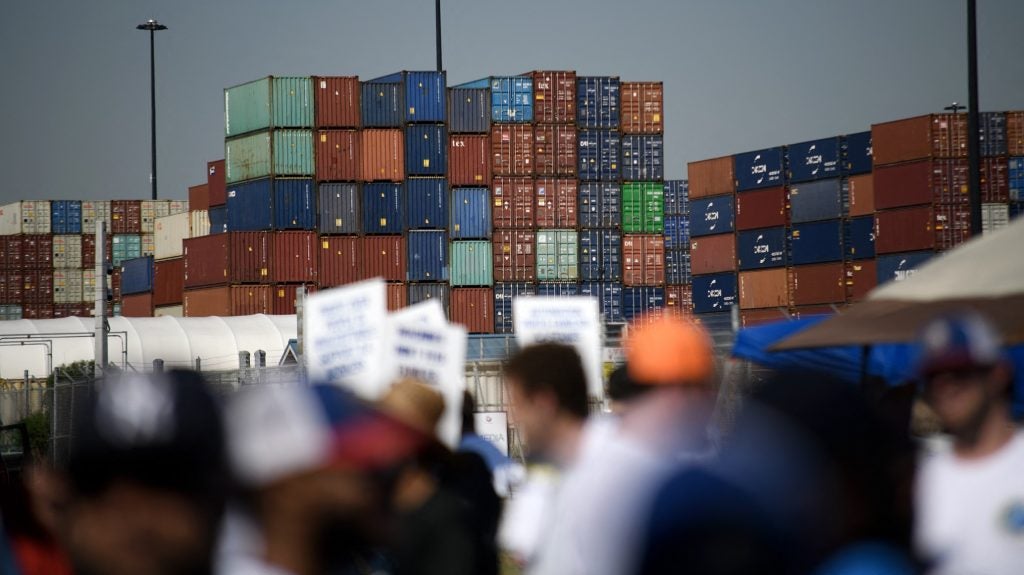
A large-scale port strike in the US started on Tuesday (1 October), sparking fears over trade flows from and into the country, including of agri-food products.
The action centres on a pay dispute and takes in ports up and down the East Coast and along to Texas on the Gulf Coast.

Discover B2B Marketing That Performs
Combine business intelligence and editorial excellence to reach engaged professionals across 36 leading media platforms.
What’s behind the strike action?
The International Longshoremen’s Association (ILA) union representing 45,000 port workers has shut down all ports from Maine on the East Coast to Texas on the Gulf Coast, encompassing the big-city ports of New York, Baltimore, Houston and New Orleans. The strike affects 36 ports in total.
It’s all about pay. The ILA has been locked in negotiations with the United States Maritime Alliance (USMX) employer group over new six-year contracts but no agreement was met before a midnight 30 September contract expiry deadline.
The USMX said in a statement it had offered to hike wages by nearly 50%, from a previous offer, but the ILA said the USMX’s final offer falls “far short of the demands of its members to ratify a new contract”. The ILA also wants the USMX to agree to its demands to stop port automation projects.
How big a problem is it?
It has been described as the largest strike of its kind in 50 years, while Sylvain Charlebois, a professor of food policy and distribution at Canada’s Dalhousie University, described it as the “mother of all strikes”.

US Tariffs are shifting - will you react or anticipate?
Don’t let policy changes catch you off guard. Stay proactive with real-time data and expert analysis.
By GlobalDataAnd that might not be hyperbole.
The US Chamber of Commerce points out that these ports collectively handle more than 68% of all containerised exports and 56% of imports for the nation, with a daily trade value exceeding $2.1bn.
The National Retail Federation noted recently that economists believe a similar disruption in 2002, but not on this scale, cost the economy $1bn per day and it took six months for the economy to recover.
The walkout is said to have halted the flow of about half the nation’s ocean shipping, impacting imports and exports across numerous sectors, including pharmaceuticals, automotive and, of course, agri-food.
News agency Reuters quoted Rick Cotton, executive director of the Port Authority of New York and New Jersey, as saying there are nearly 100,000 containers in New York City-area ports alone waiting to be unloaded.
Analysts have warned the disruption and increased shipping costs could ultimately threaten jobs, presage price increases and stoke inflation.
Retailers account for about half of all container shipping volume, Reuters pointed out, and the winter holiday and sales season is fast approaching.
While some companies have managed to work ahead of the expected strike deadline, accelerating shipments or routing to West Coast ports, others have not.
And bear in mind US trade is already facing major headwinds.
The Port of Baltimore, a key site for importing sugar, was closed after the vessel Dali knocked out the Francis Scott Key Bridge, while parts of the East Coast are still feeling the impact of Hurricane Helene, which is expected to slow the transport of goods throughout the country.
It could also stoke shipping cost increases that may be passed on to consumers already frustrated with housing and food inflation, according to logistics experts.
Days before the strike started, the US Chamber of Commerce urged President Biden to step in to avert a strike, while an agriculture organisation warned of the economic consequences.
The American Farm Bureau Federation suggested in a report that disruption at the East and Gulf Coasts ports could cost the economy billions of dollars in agri-food exports and imports.
“Over a one-week period, the potential value of disrupted containerised ag exports is estimated at $318m,” the Federation noted.
Longer term, port congestion and supply chain disruptions resulting from the port strike would force shippers to use longer ocean routes and longer inland routes to move commodities to US and international markets. Ports predict that for every day of a strike, it will take approximately five to seven days to clear.
Even a one-week strike this month could cause slowdowns well into November, some analysts suggest.
What are the implications for food?
Fresh fruits and vegetables, especially those coming from Central and South America, are expected to be most impacted by the strike, according to analysts.
Three-quarters of the nation’s banana imports from countries like Guatemala and Ecuador land at ports on the East and Gulf Coasts
Obviously, these are items that supermarket chains can’t build stocks of because of expiry issues.
In terms of food imports generally, European manufacturers are expected to face more disruption than brands that ship from Asia because of the ports they use.
A prolonged strike would also affect container exports of soybeans and soybean meal and would have a significant impact on chilled or frozen meat and eggs, industry experts say.
The $18bn a year US beef and pork export market and the $5.8bn poultry and egg export sector rely on refrigerated containers that cannot sit idle for long.
It is estimated about 45% of all waterborne US pork exports and 30% of beef exports were shipped via East Coast and Gulf Coast ports in the first seven months of this year.
What has been the food industry’s response?
Deep concern would seem to sum it up.
Industry bodies have issued warnings about the ramifications of a lengthy strike and have urged the parties to get back around the negotiating table.
US Meat Export Federation (USMEF) spokesperson Joe Schuele told Just Food: “Since early summer when the contract negotiations first broke down, USMEF has warned of the severe impact a strike will impose.”
He added: “In a typical week, more than $100m in US pork and beef is exported through the East and Gulf Coast ports. While exporters have redirected some shipments to the West Coast, this is simply not an option for many products bound for certain destinations. We hope to see the parties back at the bargaining table soon and to see heightened efforts to resolve this dispute.”
Similarly urging the parties to resume talks is Leslie Sarasin, president and CEO of the food industry association FMI.
“There’s never a good time for a strike. Now, the current strike is compounding the horrific situation in the south-eastern United States resulting from Hurricane Helene and parties need to return to the negotiating table,” he said.
“The strike on the East and Gulf Coasts by the International Longshoremen’s Association threatens to make the situation even more dire. This action has already begun to jeopardise food supply chain operations and the strike has the potential to disrupt the long-term stability of markets and commodities, namely pharmaceuticals, seafood, produce, meat, cheese, ingredients and packaging.”
He added: “An extended strike will likely cause dramatic increases in the cost and availability of goods, intensifying this inflationary environment. And, unfortunately, this situation cannot be addressed by a switch to alternative ports due to the freight costs and time associated with transporting products back to the East Coast.”

Echoing those views is Tom Madrecki, vice president of campaigns and special projects at the Consumer Brands Association.
“This strike will have significant consequences for consumer packaged goods manufacturers and consumers and the broader US economy,” he said.
“The shutdown of East Coast ports will imperil the import and export of perishable products, which are critical to maintaining the availability and affordability of many everyday products all around the world.”
USA Poultry & Egg Export Council (USAPEEC) president and CEO Greg Tyler said his organisation has joined forces with more than 177 other associations to advocate for a peaceful resolution between the ILA and USMX.
“A strike would have a significant negative impact on US poultry and egg exports from ports on the Gulf Coast and the East Coast,” he said.
“Disruptions could result in delays, increased costs and losses for exporters. Based on export data for the January-July 2024 period, the weekly loss to US poultry and egg exports is projected to be about $63.6m.”
Staying with the numbers, National Milk Producers Federation CEO Gregg Doud said on Fox News that the strike will cost the dairy industry about $32m a week while more generally it will cost about $320m a week in total agri-food exports out of the container ports on the East Coast and $1.1bn in imports.
From a packaged food company perspective, preparedness will be the key to the impact they face.
Brendan Foley, president and CEO of sauces and spices major McCormick and Co., said: “From an inbound supply planning perspective for us, we’ve been contingency planning on this on the potential for this since like April of this year. We really have been thinking about this as maybe something that could happen.”
He said the company has coordinated mitigation plans with its domestic suppliers because they might be counting on inbound supply coming from outside the US.
“So we believe we’ve mitigated most of those risks with the strike now officially occurring,” he said.
How long is the strike likely to last?
Difficult to say with any certainty but most informed opinion suggests it won’t be prolonged.
Eric Clark, a portfolio manager at Accuvest Global Advisors, said: “I would be shocked if this lasted more than a week due to the domino effects from the strike growing exponentially the longer a strike happens.”
The Biden Administration has so far avoided becoming embroiled in the dispute, ruling out the use of federal powers to break the strike, but it will be concerned about how a major stoppage, which could see shortages on supermarket shelves, would be viewed by voters weeks before a presidential election.
As Reuters noted: “The dispute is also wedging labour-friendly US President Joe Biden into a virtual no-win position as Vice President Kamala Harris runs a razor-tight election race against Republican former President Donald Trump.”
However, President Biden doesn’t seem to be sitting on the fence. In a late Tuesday post on X he came out on the side of the union.
He said: “Foreign ocean carriers have made record profits since the pandemic, when longshoremen put themselves at risk to keep ports open. It’s time those ocean carriers offered a strong and fair contract that reflects ILA workers’ contribution to our economy and to their record profits.”
The pressure then is on the USMX to improve its offer. But whether it will be prepared to scale back automation plans as well as putting additional money on the table remains uncertain.
And this seems to be a line in the sand for ILA’s leader, Harold Daggett.
“We are prepared to fight as long as necessary, to stay out on strike for whatever period of time it takes, to get the wages and protections against automation our ILA members deserve,” he said on Tuesday.





